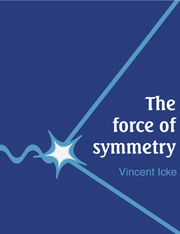Book contents
- Frontmatter
- Contents
- Preface
- Introduction
- 1 A matter of force
- 2 Stalking the wild rainbow
- 3 Light
- 4 Maybe I'm Heisenberg
- 5 Catch a falling quantum
- 6 Quantum beanbags
- 7 Symmetries
- 8 Quantum relativity: nothing is relative
- 9 Life, the Universe and everything
- 10 The physics of a tablecloth
- 11 Colour me red, green and blue
- 12 Smashing symmetry
- 13 How much is infinity minus infinity?
- 14 Excelsior! The ascent to SU(∞)
- A modest reading proposal
- References
- Glossary
- Index
3 - Light
Published online by Cambridge University Press: 05 August 2012
- Frontmatter
- Contents
- Preface
- Introduction
- 1 A matter of force
- 2 Stalking the wild rainbow
- 3 Light
- 4 Maybe I'm Heisenberg
- 5 Catch a falling quantum
- 6 Quantum beanbags
- 7 Symmetries
- 8 Quantum relativity: nothing is relative
- 9 Life, the Universe and everything
- 10 The physics of a tablecloth
- 11 Colour me red, green and blue
- 12 Smashing symmetry
- 13 How much is infinity minus infinity?
- 14 Excelsior! The ascent to SU(∞)
- A modest reading proposal
- References
- Glossary
- Index
Summary
Waves of light
Light behaves like a wave. In the laboratory, we can measure the vibrations that are set up in matter when a light wave comes by. We can also observe the peculiar light-and-dark patterns that occur when two light rays are made to act simultaneously, an unmistakable sign of wave behaviour.
Let us make a small excursion into wave motion. Throughout this exposition, you are encouraged to experiment as much as possible with waves (preferably real ones, or at least those in the diagrams), to become familiar with their fascinating behaviour. Water waves in the bathtub, or those seen on open water from a high tower or an airplane, are especially instructive.
Waves are periodic; if you pick a point in space (e.g. the surface of a pond at the point where a reed pokes through) and you watch the motion of the wave carrier (the water that bobs up and down), then you will see that the state of motion of the carrier repeats itself at regular intervals of time. This interval is the period of the wave. A free wave has a velocity, i.e. a direction and a speed. At a given point, a wave alternates periodically between a certain maximum and a minimum.
- Type
- Chapter
- Information
- The Force of Symmetry , pp. 32 - 50Publisher: Cambridge University PressPrint publication year: 1995



